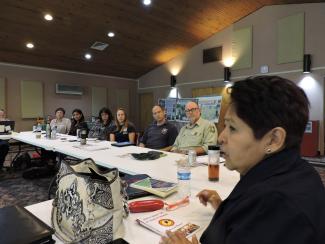Tribal Relations
Native tribes of Southern Illinois

Native tribes share a common history of colonization and its resulting detrimental consequences, but each tribe is distinct. Each has a unique history, origin story, culture, language, traditional food and other facets that shape their identities.
The earliest written accounts of the Illinois Indians, ca. 1639, authoritatively specify they occupied lands bounded by the Wisconsin, Ohio, Wabash, and Mississippi Rivers in 60 villages with over 20,000 men or warriors. The Illinois called themselves "inoca" while French explorers and missionaries generally referred to them as "Illinois.” There may have been as many as 12 different Illinois tribes, however, by the end of the century seven of these tribes--including the Chepoussa, Chinkoa, Coiracoentanon, Espeminkia, Maroa, Moingwena, and Tapouaro--had disappeared or merged with other Illinois tribes. Five principal tribes survived into the 1700s: the Cahokia, Kaskaskia, Michigamea, Peoria, and Tamaroa. Only the Kaskaskia and Peoria continued to exist in the early 1800s.
Much later the Kaskaskia, Cahokia, Mitchigamia, Peoria and Tamaroa Tribes ceded most of the land which is now occupied by the Shawnee National Forest. In 1803 and again in 1818 the US government acknowledged that the Illinois Tribes occupied “the extensive tract of country which of right belongs to them and which was possessed by their ancestors for many generations,… do relinquish and cede to the United States all the lands in the Illinois country, which the said tribe has heretofore possessed, or which they may rightfully claim,…”
Other tribes known to have also lived on and used the lands of southern Illinois included the Delaware, Shawnees, Potawatomie, Miami, Eel River (the Miami), Wea, Kickapoos, and Piankashaw.
Partners improve Hamburg Hill Trailhead - An Original Cherokee Trail of Tears National Historic Trail
Throgh a joint effort with the help of the Tribal Historic Preservation Office of the Cherokee Nation, the United Keetoowah Band of Indians in Oklahoma, the National Trail of Tears Association and the National Park Service, improvements have been made to the trailhead at Hamburg Hill in Union County, IL. The partners designed and restored the original Trail of Tears trail segment at Hamburg Hill west to the Mississippi River floodplain. A visitor parking area, rustic comfort station, picnic table, benches, and walkway and steps to the trail segment were installed at Hamburg Hill. Past ATV and weather-related damage was rehabilitated, and interpretive signs were installed.
The interpretive signage commemorates the hard winter journey of the Cherokee across southern Illinois. During the Cherokee’s Trail of Tears journey across southern Illinois, the Mississippi River ferries were not running because of ice flows on the river. As a result, thousands of Cherokees were trapped east of the river and are thought to have camped along the trail clean freshwater springs and near mills where corn for themselves and their livestock was readily available. While John Ross and his family was traveling west by water, he left his steamboat at Cairo and traveled to Union County to reassure, comfort, encourage the Cherokee as they waited for the Mississippi River to thaw so they could resume their journey to the government-assigned lands in Oklahoma. He was also able to arrange for much needed winter supplies such as warm blankets, clothing and tents to help sustain them as they waited for the ice floes to melt.
Strengthening relationships
Native Americans have lived in southern Illinois for the last 12,000 years. Their roots are deeply imbedded in lands now known as the Shawnee National Forest. The Shawnee National Forest honors the treasured, strong, and enduring cultures and contributions of all Native Americans and invite our federally-recognized tribes to partner with us to create a vibrant tribal engagement program where all tribal citizens are welcomed and received with the respect their tribal sovereignty compels.
Since 2014, the Shawnee National Forest has partnered with a number of tribes in a program called Southern Skies where federally-recognized tribal students have visited the Forest and participated in activities that would connect them with the eastern woodlands, such as archaeological excavations, hikes along the Trail of Tears National Historic Trail, canoeing the Cache River, snorkeled Big Creek and Hutchins Creek participated in a “bioblitz” on Rim Rock National Recreation Trail.

In an effort to connect Tribal leaders with southern Illinois, the Shawnee National Forest also hosted a group of Tribal leaders in the fall of 2018 when the group toured a number of iconic Shawnee sites such as Garden of the Gods and the Snake Road, but also learned about the Great Salt Springs, the Cherokee Trail of Tears in southern Illinois and the Millstone Bluff Archaeological Site. Some members of the group shared their own tribal stories about their ancestral homelands and how they were removed west to Oklahoma during the 1830s and 1840s. Even though they were cruelly forced to leave the homelands in Illinois, Indiana, Missouri, Ohio, Pennsylvania, and West Virginia they have retained their tribal identity and sovereignty and their vibrant cultural traditions today in Oklahoma!


